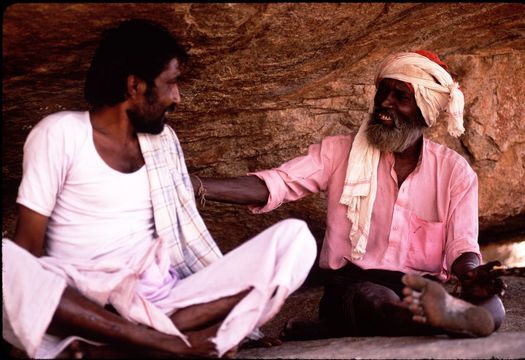 This is Mr. Not-Natural in
This is Mr. Not-Natural in 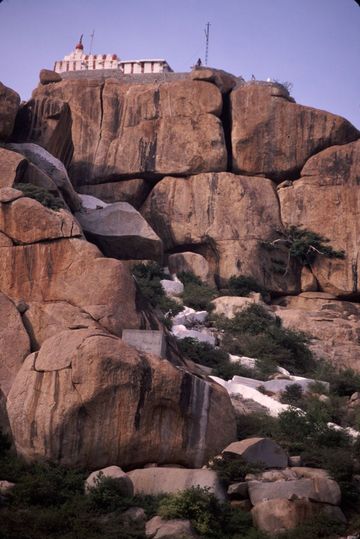 The Hanuman temple with its 576 steps and countless monkeys. I wasn't exactly sure how to get past the monkeys, but then I followed a couple of worshippers heading up the steps who had walking sticks which they whacked at the monkeys when they came near.
The Hanuman temple with its 576 steps and countless monkeys. I wasn't exactly sure how to get past the monkeys, but then I followed a couple of worshippers heading up the steps who had walking sticks which they whacked at the monkeys when they came near. |
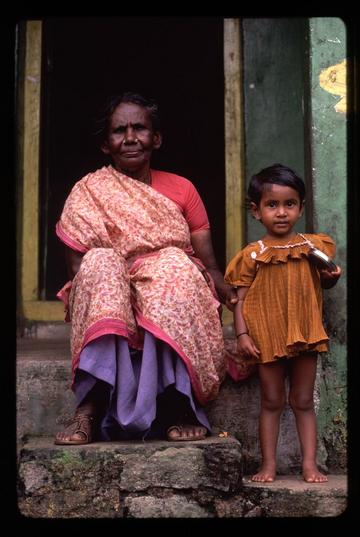 An old woman and child sitting on their doorstep in a small village near Hampi, Karnataka state.
An old woman and child sitting on their doorstep in a small village near Hampi, Karnataka state. |
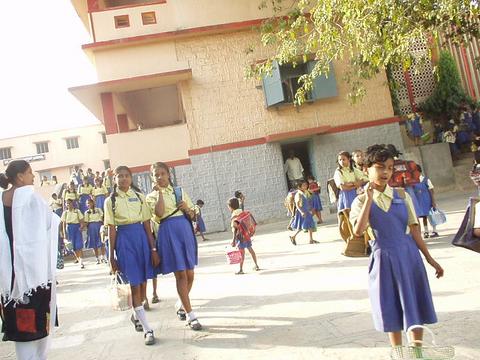 This is in Gulbarga, Nothern Karnataka, and home of Preethi, Hari's wife; Preethi is at left, viewing schoolgirls streaming out of her alma mater. Shortly after they arrived in Gulbarga from Hyderabad, Hari and Preethi phoned me an inviatation to stay at her place, and I took them up on it; it was only a one day stay, but since Gulbarga is on the rail line from Hampi to Delhi, it was convenient. Preethi's mom is a good cook; if anyone is ever in Gulbarga you should stop in for some milk puris. They taste like an elephant ear, only better, and as far as they know, are unobtainable in most of India.
This is in Gulbarga, Nothern Karnataka, and home of Preethi, Hari's wife; Preethi is at left, viewing schoolgirls streaming out of her alma mater. Shortly after they arrived in Gulbarga from Hyderabad, Hari and Preethi phoned me an inviatation to stay at her place, and I took them up on it; it was only a one day stay, but since Gulbarga is on the rail line from Hampi to Delhi, it was convenient. Preethi's mom is a good cook; if anyone is ever in Gulbarga you should stop in for some milk puris. They taste like an elephant ear, only better, and as far as they know, are unobtainable in most of India. |
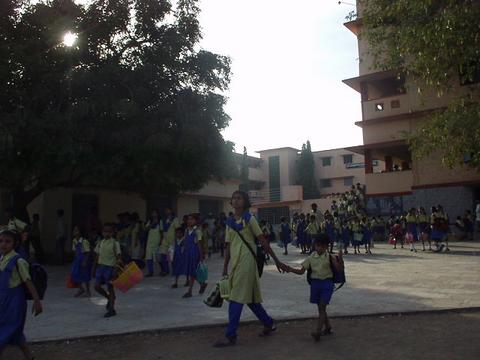 As with the burkha-wearing women of Charminar, it is difficult to convey the volume of people at Preethi's school. For over five minutes there was a constant stream of uniformed schoolgirls heading out after school.
As with the burkha-wearing women of Charminar, it is difficult to convey the volume of people at Preethi's school. For over five minutes there was a constant stream of uniformed schoolgirls heading out after school. |
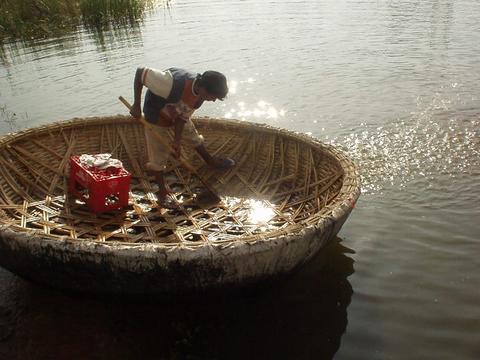 There are a few too many tourist shops and services on the south side of the river, so I stayed to the north, which meant "commuting" to the south side most days in a coracle. Although the bottoms of the boats were thoroughly covered in tar, they still leaked a bit. Passengers got their feet wet, whatever was on the bottom of your pack got a bit soaked, and every few trips the paddler would have to shovel the water out of his vessel, like this.
There are a few too many tourist shops and services on the south side of the river, so I stayed to the north, which meant "commuting" to the south side most days in a coracle. Although the bottoms of the boats were thoroughly covered in tar, they still leaked a bit. Passengers got their feet wet, whatever was on the bottom of your pack got a bit soaked, and every few trips the paddler would have to shovel the water out of his vessel, like this. |
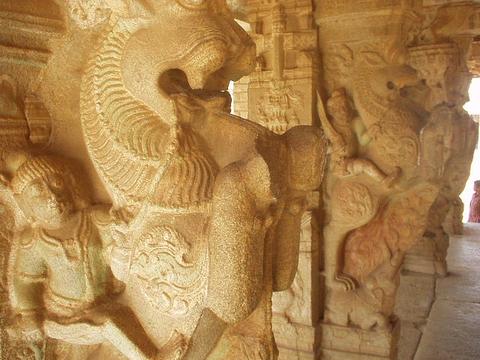 The perimeter of the main temple, as well as some of the outlying buildings, had a host of these warriors, mounted either on lions or elephants.
The perimeter of the main temple, as well as some of the outlying buildings, had a host of these warriors, mounted either on lions or elephants. |
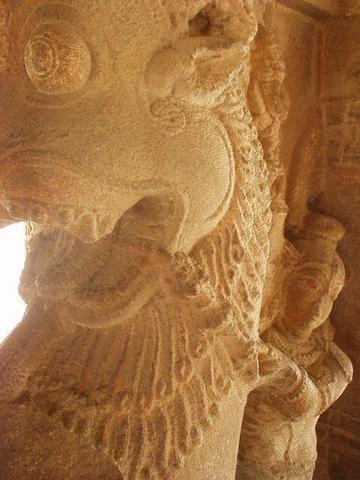
|
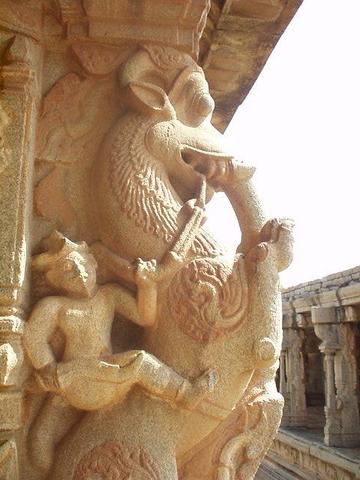
|
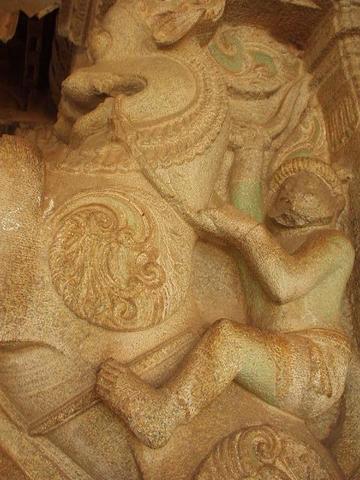
|
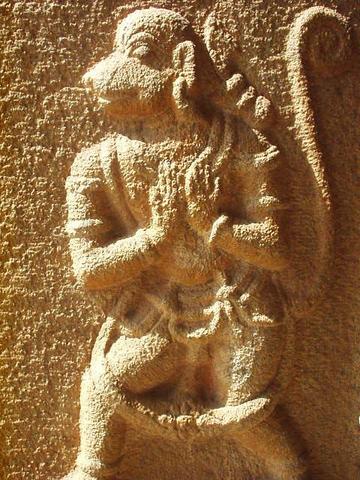 This is an icon of Hanuman, the monkey god. There is a still-functioning Hanuman temple a few miles away that I also visited.
This is an icon of Hanuman, the monkey god. There is a still-functioning Hanuman temple a few miles away that I also visited. |
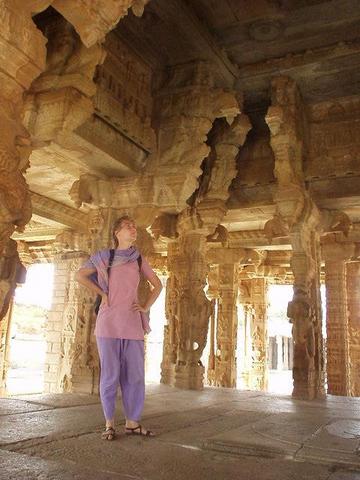 I ran into the Frenchwomen from Ooty here, going across the river on the coracle. Here is one of them, Angelique, examining the ceiling of the main temple.
I ran into the Frenchwomen from Ooty here, going across the river on the coracle. Here is one of them, Angelique, examining the ceiling of the main temple. |
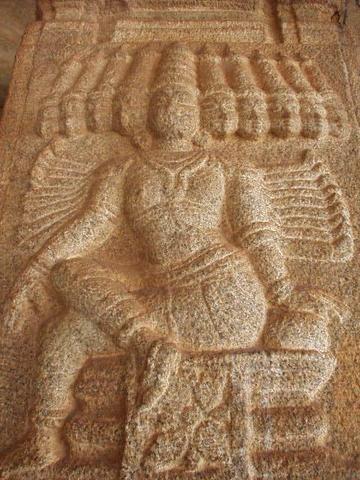 Ravana with his ten heads and arms. He gets them all lopped off by Rama in the Ramayana.
Ravana with his ten heads and arms. He gets them all lopped off by Rama in the Ramayana. |
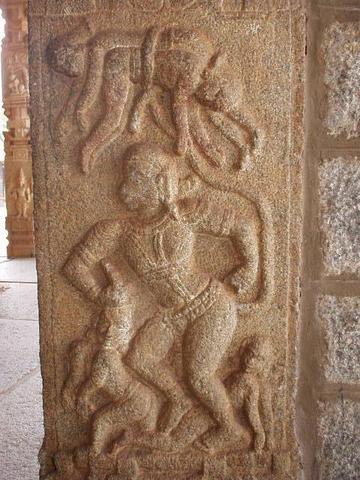 Hanuman again, whipping his enemies about with his tail and then stomping on them.
Hanuman again, whipping his enemies about with his tail and then stomping on them. |
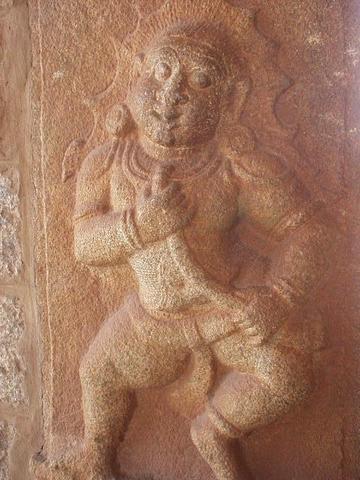 I don't know who this is.
I don't know who this is. |
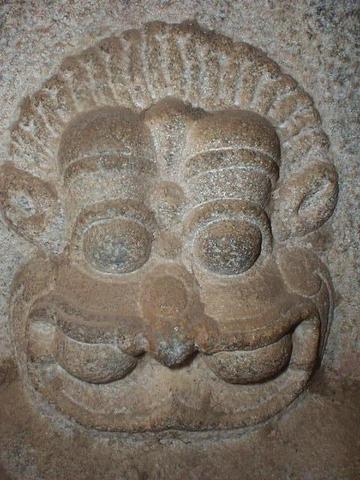 Like superheroes in need of a new power suit, Hindu gods reincarnate themselves in new forms, usually to complete a quest or task. Vishnu arrived on earth as Narasimha, his man-lion incarnation, to defeat the evil king Hiranyakashipu who had become overly powerful after Brahma gave him one too many blessings. There are a lot of Narasimha icons carved into the rock around Hampi.
Like superheroes in need of a new power suit, Hindu gods reincarnate themselves in new forms, usually to complete a quest or task. Vishnu arrived on earth as Narasimha, his man-lion incarnation, to defeat the evil king Hiranyakashipu who had become overly powerful after Brahma gave him one too many blessings. There are a lot of Narasimha icons carved into the rock around Hampi. |
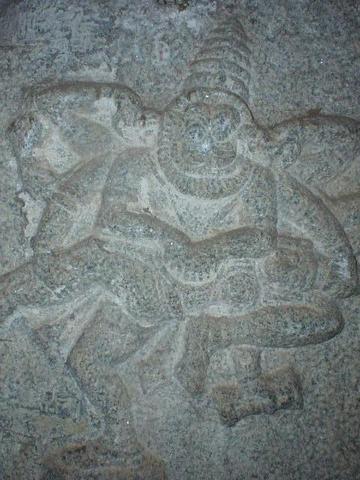 Vishnu, as Narasimha, gobbling the evil king Hiranyakashipu's entrails.
Vishnu, as Narasimha, gobbling the evil king Hiranyakashipu's entrails. |
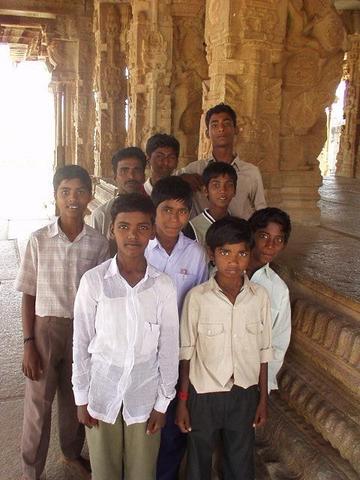 Each time I take a picture with my digital camera, it shows up on the screen on the back for three or four seconds. One of these schoolboys, visiting the temple on a school trip, noticed this and told his friends; soon I was leading a gaggle of schoolboys around the temple, as they craned to see the images as they showed up. I indulged them with a picture, and they were, as is frequently the case, fascinated to see their own image on the camera.
Each time I take a picture with my digital camera, it shows up on the screen on the back for three or four seconds. One of these schoolboys, visiting the temple on a school trip, noticed this and told his friends; soon I was leading a gaggle of schoolboys around the temple, as they craned to see the images as they showed up. I indulged them with a picture, and they were, as is frequently the case, fascinated to see their own image on the camera. |
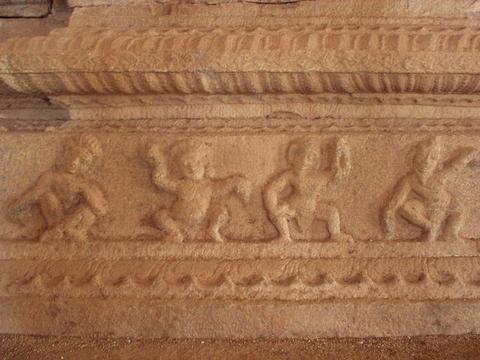 I was thinking it would be pretty neat to stitch these together into a panoramic at some point, so there will be a short succession of pictures of this frieze...
I was thinking it would be pretty neat to stitch these together into a panoramic at some point, so there will be a short succession of pictures of this frieze... |
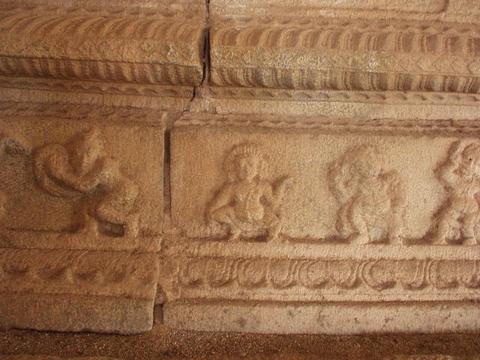
|
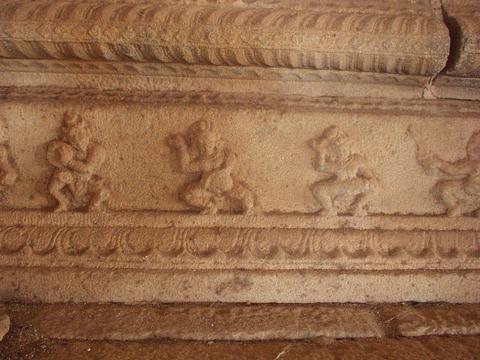
|
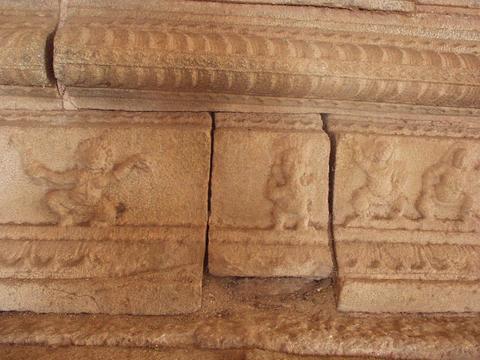
|
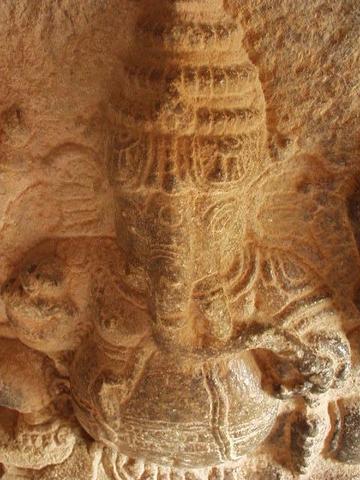 The elephant headed god, Ganesh.
The elephant headed god, Ganesh. |
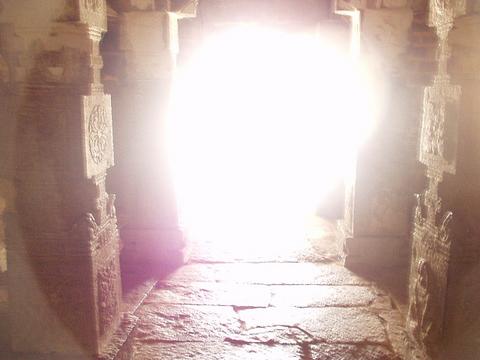 And then, in one of the small temples on the perimeter, the light of Brahma descended... just kidding, just kidding.
And then, in one of the small temples on the perimeter, the light of Brahma descended... just kidding, just kidding. |
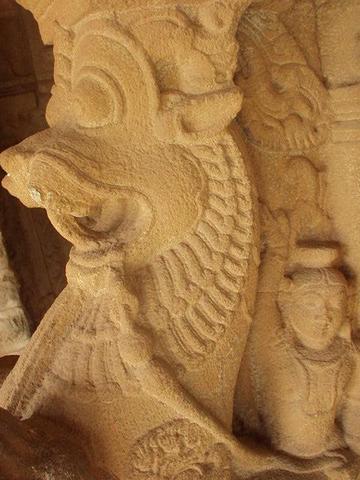 I was, as you can see, rather enchanted with the warrior-statues that ringed the temple...
I was, as you can see, rather enchanted with the warrior-statues that ringed the temple... |
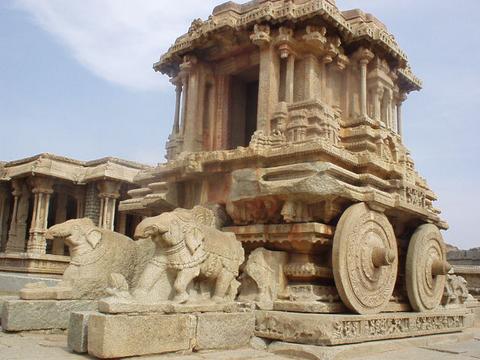 I neglected to look inside, but supposedly there is an image of Garuda, Vishnu's man-bird vehicle. The wheels are independent of the chassis, and supposedly it once was able to move. It looks like it still could be budged, but pushing around World Heritage monuments to see how far you can roll them is, generally speaking, discouraged.
I neglected to look inside, but supposedly there is an image of Garuda, Vishnu's man-bird vehicle. The wheels are independent of the chassis, and supposedly it once was able to move. It looks like it still could be budged, but pushing around World Heritage monuments to see how far you can roll them is, generally speaking, discouraged. |
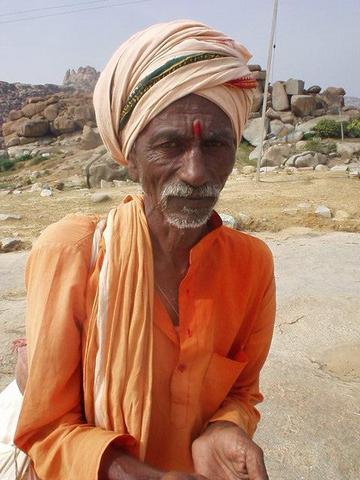 There was a string of Hindu holy men, or Sadhus, asking for money on the path between Hampi bazaar and the Vittala Temple. This is one of them.
There was a string of Hindu holy men, or Sadhus, asking for money on the path between Hampi bazaar and the Vittala Temple. This is one of them. |
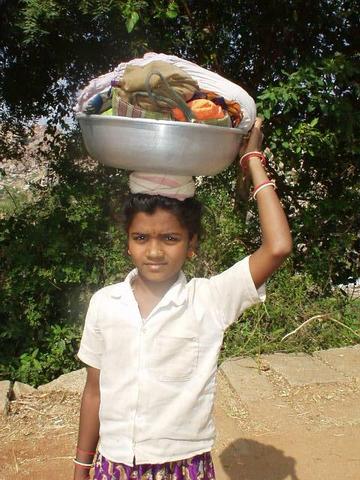 Indians can carry a flabbergasting amount of stuff on their heads. This is a very small load; the most impressive are firewood or hay; because they are not very dense, people can carry large volumes of them. Hay-carriers look like one of the McDonald's fry guys, a cascade of fluff made mobile by a pair of legs beneath.
Indians can carry a flabbergasting amount of stuff on their heads. This is a very small load; the most impressive are firewood or hay; because they are not very dense, people can carry large volumes of them. Hay-carriers look like one of the McDonald's fry guys, a cascade of fluff made mobile by a pair of legs beneath.
|
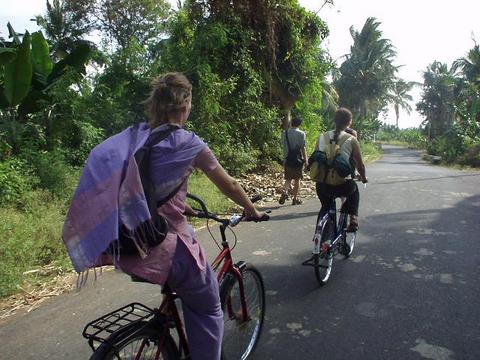 Since the two major attractions of the town are a few kilometers apart, we rented bikes, "Hero Atlas" models that have to weigh sixty pounds each. Céline's pedal locked up against her chain guard and she had to kick at it for several minutes before it would work again; my right pedal slowly disintegrated throughout the day until there was just the central shaft of the pedal left. Other than that, they worked great.
Since the two major attractions of the town are a few kilometers apart, we rented bikes, "Hero Atlas" models that have to weigh sixty pounds each. Céline's pedal locked up against her chain guard and she had to kick at it for several minutes before it would work again; my right pedal slowly disintegrated throughout the day until there was just the central shaft of the pedal left. Other than that, they worked great. |
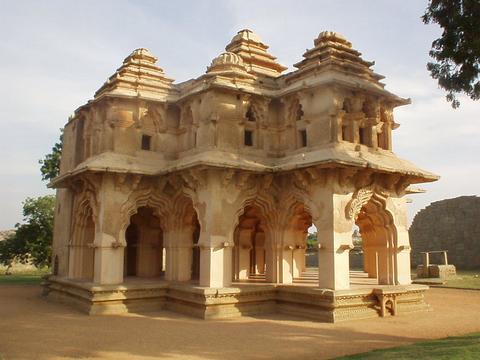 The Lotus Mahal, in the Zenana enclosure, Hampi. This is frequently cited as a prime example of Indo-Islamic architecture. The foliated, recessed arches are Islamic in style, with the pointed apex; the stacked spires on the second story are seen on Hindu temples everywhere. This was built sometime in the fifteenth century; Islam was well established in the North, and was slowly percolating its way south. The Vijayanagars flourished from about 1336, when Hampi was founded, until 1565. In that year, five sultanates of the Deccan plateau, who had for several hundred years been sqabbling among themselves, combined forces and squashed the Vijaynagars at the battle of Talikota. Although Rajput Hindus in particular held high offices in the Moghul and then British empire, the Vijaynagars were the last major Hindu government until 1947.
The Lotus Mahal, in the Zenana enclosure, Hampi. This is frequently cited as a prime example of Indo-Islamic architecture. The foliated, recessed arches are Islamic in style, with the pointed apex; the stacked spires on the second story are seen on Hindu temples everywhere. This was built sometime in the fifteenth century; Islam was well established in the North, and was slowly percolating its way south. The Vijayanagars flourished from about 1336, when Hampi was founded, until 1565. In that year, five sultanates of the Deccan plateau, who had for several hundred years been sqabbling among themselves, combined forces and squashed the Vijaynagars at the battle of Talikota. Although Rajput Hindus in particular held high offices in the Moghul and then British empire, the Vijaynagars were the last major Hindu government until 1947. |
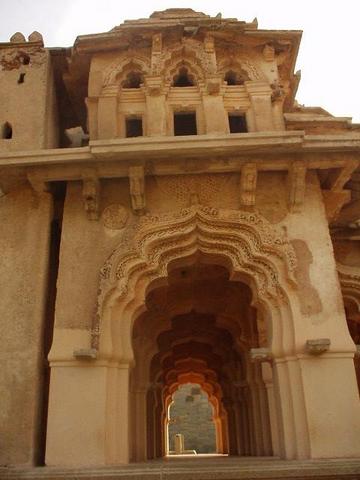 The Lotus Mahal, although not physically very large, was impressive in the use of light -- the succession of arches goes from light to dark and back again. It was evidently used as a "ladies retiring station".
The Lotus Mahal, although not physically very large, was impressive in the use of light -- the succession of arches goes from light to dark and back again. It was evidently used as a "ladies retiring station". |
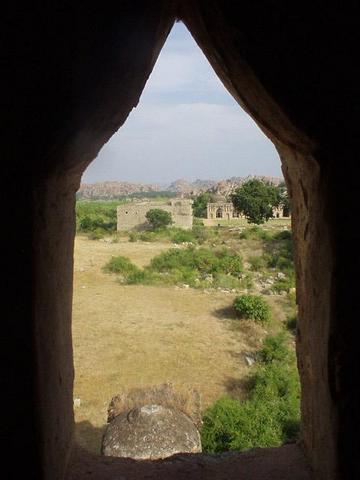 There was one big tower leading up to commanding views of the Zenana enclosure; this is a view out of one of its windows.
There was one big tower leading up to commanding views of the Zenana enclosure; this is a view out of one of its windows. |
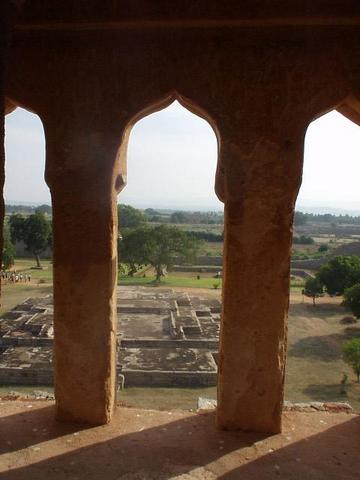 These three windows, at the apex of the tower, were open, and it was quite pleasant to sit in one of them and imagine myself the ruler of a vast Hindu empire. The large platform you can see just outside was smack in the middle of the main courtyard.
These three windows, at the apex of the tower, were open, and it was quite pleasant to sit in one of them and imagine myself the ruler of a vast Hindu empire. The large platform you can see just outside was smack in the middle of the main courtyard. |
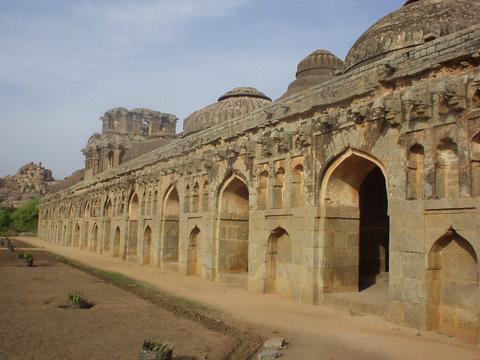 These are the elephant stables, which form the entire wall on one side of the Zenana enclosure. There are elevent of them, and each one looked big enough to hold two elephants, or perhaps one if they were treated very regally. There were small, man-sized doors leading in between each of the rooms, so that the keepers could visit each of the stables without having to open the enormous elephant-doors.
These are the elephant stables, which form the entire wall on one side of the Zenana enclosure. There are elevent of them, and each one looked big enough to hold two elephants, or perhaps one if they were treated very regally. There were small, man-sized doors leading in between each of the rooms, so that the keepers could visit each of the stables without having to open the enormous elephant-doors. |
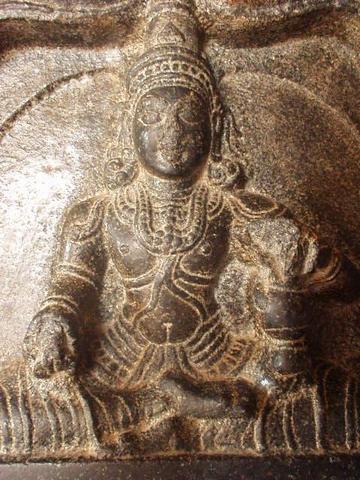 A carved figure of a woman meditating, in the Zenana Enclosure.
A carved figure of a woman meditating, in the Zenana Enclosure. |
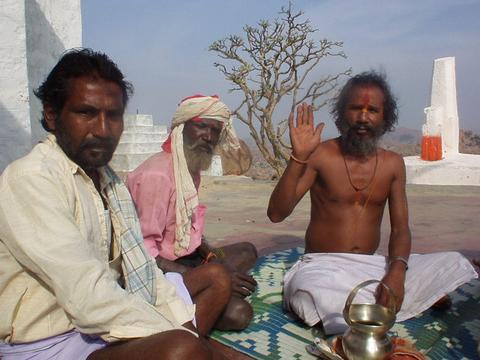 I visited the Hanuman temple that was a few kilometers from the Hampi bazaar. The man on the left was quiet and pensive; the one in the center was an eccentric fool who spoke English in almost a schizophrenic "word salad" -- but then there were little threads of coherency though them ("George Bush daughter LSD taking, yes?" stands out in my mind), and he seemed to be able to formulate what souned like complete thoughts in Kannada. The man with the upraised hand was the guru. I asked if I could take his picture -- actually I asked the fool, who said "after smoking, after smoking." What he meant, it turned out, was immediately after smoking: I now have a series of photographs on slide film of the process of the fool lighting the guru's chillum pipe, stuffed with ganja, and then the guru's eyes bulging as he inhales. Sadly, we will all have to wait for nine months to see that, when I develop the film back in the United States.
I visited the Hanuman temple that was a few kilometers from the Hampi bazaar. The man on the left was quiet and pensive; the one in the center was an eccentric fool who spoke English in almost a schizophrenic "word salad" -- but then there were little threads of coherency though them ("George Bush daughter LSD taking, yes?" stands out in my mind), and he seemed to be able to formulate what souned like complete thoughts in Kannada. The man with the upraised hand was the guru. I asked if I could take his picture -- actually I asked the fool, who said "after smoking, after smoking." What he meant, it turned out, was immediately after smoking: I now have a series of photographs on slide film of the process of the fool lighting the guru's chillum pipe, stuffed with ganja, and then the guru's eyes bulging as he inhales. Sadly, we will all have to wait for nine months to see that, when I develop the film back in the United States. |
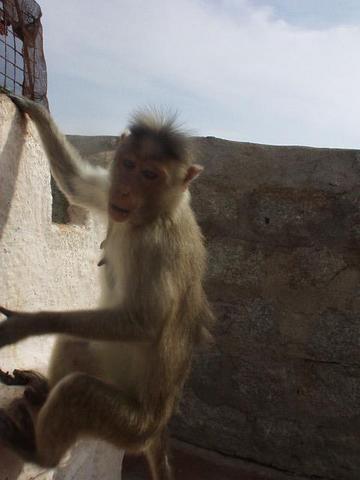 It was ironic that the devotees and gurus of Hanuman, the god of monkeys, should be plagued by simian pests. This is one of the Langur monkeys that kept clambering around and trying to get in to the temple where there were people living and (more importantly) cooking. One of the temple devotees would then have to give up chatting, smoking, or meditating and chase after it, hissing loudly.
It was ironic that the devotees and gurus of Hanuman, the god of monkeys, should be plagued by simian pests. This is one of the Langur monkeys that kept clambering around and trying to get in to the temple where there were people living and (more importantly) cooking. One of the temple devotees would then have to give up chatting, smoking, or meditating and chase after it, hissing loudly. |
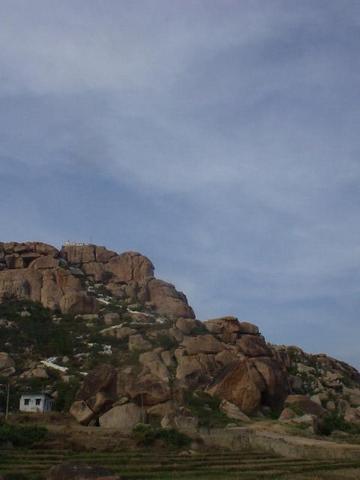 It was quite a hike up to the Hanuman temple; you can see the white stairwell (well populated with monkeys) leading up the hill with the temple at top, blending into the sky.
It was quite a hike up to the Hanuman temple; you can see the white stairwell (well populated with monkeys) leading up the hill with the temple at top, blending into the sky. |
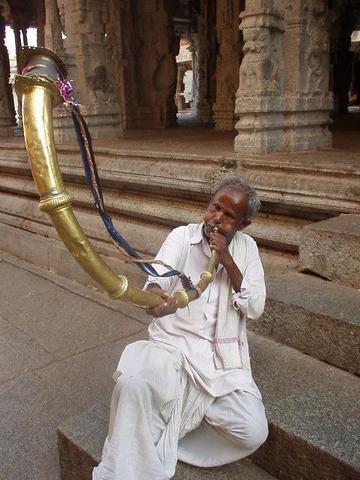 Most of the shops in the Hampi bazaar are occupying buildings that housed subjects of the Vijaynagar empire, and the nearby Virupaksha temple (named after an incarnation of Shiva) has similarly been repopulated. It was also built by the Vijayanagars, in 1442. This man is blowing a horn called a kompu.
Most of the shops in the Hampi bazaar are occupying buildings that housed subjects of the Vijaynagar empire, and the nearby Virupaksha temple (named after an incarnation of Shiva) has similarly been repopulated. It was also built by the Vijayanagars, in 1442. This man is blowing a horn called a kompu. |
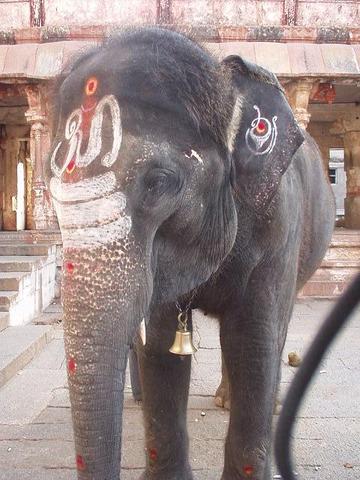 The elephant of the Virupaksha temple. Most major temples -- okay, I've been to two: Madurai and this one -- have an elephant or two that has been trained to take a coin from a supplicant and then tap them on the head in blessing.
The elephant of the Virupaksha temple. Most major temples -- okay, I've been to two: Madurai and this one -- have an elephant or two that has been trained to take a coin from a supplicant and then tap them on the head in blessing. |
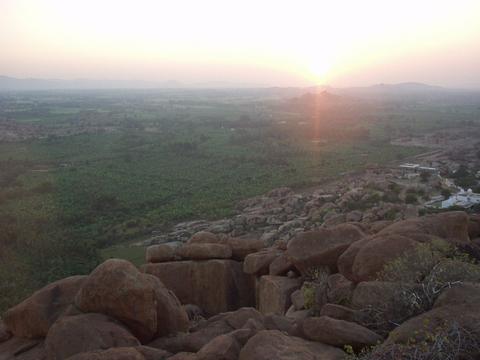 This is the view from on high at a ruined temple on Matanga hill, a perch at the end of Hampi bazaar that has not been re-colonized by shopowners. If there were any doubts as to how the monkeys sustain themselves (which are pestilent even outside of the temples; in smaller towns it is generally advisable to close your windows when you leave, lest your room get ransacked by them), the fact that all of the greenery visible here is banana plantations should put them to rest.
This is the view from on high at a ruined temple on Matanga hill, a perch at the end of Hampi bazaar that has not been re-colonized by shopowners. If there were any doubts as to how the monkeys sustain themselves (which are pestilent even outside of the temples; in smaller towns it is generally advisable to close your windows when you leave, lest your room get ransacked by them), the fact that all of the greenery visible here is banana plantations should put them to rest. |
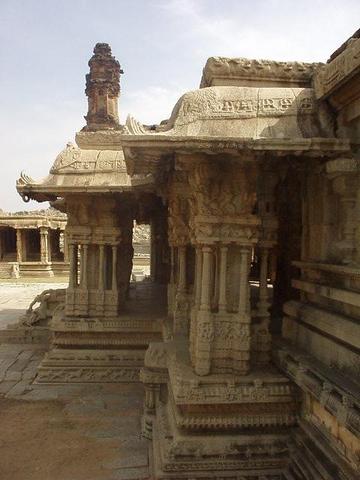 The largest and best-preserved of several Vijayanagar temples in the Hampi area, this one was started during the reign of Krishnadevaraya in the early 16th century. It was never completed or consecrated, but it is still very impressive and well preserved.
The largest and best-preserved of several Vijayanagar temples in the Hampi area, this one was started during the reign of Krishnadevaraya in the early 16th century. It was never completed or consecrated, but it is still very impressive and well preserved. |
 This is Mr. Not-Natural in
This is Mr. Not-Natural in  The Hanuman temple with its 576 steps and countless monkeys. I wasn't exactly sure how to get past the monkeys, but then I followed a couple of worshippers heading up the steps who had walking sticks which they whacked at the monkeys when they came near.
The Hanuman temple with its 576 steps and countless monkeys. I wasn't exactly sure how to get past the monkeys, but then I followed a couple of worshippers heading up the steps who had walking sticks which they whacked at the monkeys when they came near. An old woman and child sitting on their doorstep in a small village near Hampi, Karnataka state.
An old woman and child sitting on their doorstep in a small village near Hampi, Karnataka state. This is in Gulbarga, Nothern Karnataka, and home of Preethi, Hari's wife; Preethi is at left, viewing schoolgirls streaming out of her alma mater. Shortly after they arrived in Gulbarga from Hyderabad, Hari and Preethi phoned me an inviatation to stay at her place, and I took them up on it; it was only a one day stay, but since Gulbarga is on the rail line from Hampi to Delhi, it was convenient. Preethi's mom is a good cook; if anyone is ever in Gulbarga you should stop in for some milk puris. They taste like an elephant ear, only better, and as far as they know, are unobtainable in most of India.
This is in Gulbarga, Nothern Karnataka, and home of Preethi, Hari's wife; Preethi is at left, viewing schoolgirls streaming out of her alma mater. Shortly after they arrived in Gulbarga from Hyderabad, Hari and Preethi phoned me an inviatation to stay at her place, and I took them up on it; it was only a one day stay, but since Gulbarga is on the rail line from Hampi to Delhi, it was convenient. Preethi's mom is a good cook; if anyone is ever in Gulbarga you should stop in for some milk puris. They taste like an elephant ear, only better, and as far as they know, are unobtainable in most of India. As with the burkha-wearing women of Charminar, it is difficult to convey the volume of people at Preethi's school. For over five minutes there was a constant stream of uniformed schoolgirls heading out after school.
As with the burkha-wearing women of Charminar, it is difficult to convey the volume of people at Preethi's school. For over five minutes there was a constant stream of uniformed schoolgirls heading out after school. There are a few too many tourist shops and services on the south side of the river, so I stayed to the north, which meant "commuting" to the south side most days in a coracle. Although the bottoms of the boats were thoroughly covered in tar, they still leaked a bit. Passengers got their feet wet, whatever was on the bottom of your pack got a bit soaked, and every few trips the paddler would have to shovel the water out of his vessel, like this.
There are a few too many tourist shops and services on the south side of the river, so I stayed to the north, which meant "commuting" to the south side most days in a coracle. Although the bottoms of the boats were thoroughly covered in tar, they still leaked a bit. Passengers got their feet wet, whatever was on the bottom of your pack got a bit soaked, and every few trips the paddler would have to shovel the water out of his vessel, like this. The perimeter of the main temple, as well as some of the outlying buildings, had a host of these warriors, mounted either on lions or elephants.
The perimeter of the main temple, as well as some of the outlying buildings, had a host of these warriors, mounted either on lions or elephants.


 This is an icon of Hanuman, the monkey god. There is a still-functioning Hanuman temple a few miles away that I also visited.
This is an icon of Hanuman, the monkey god. There is a still-functioning Hanuman temple a few miles away that I also visited. I ran into the Frenchwomen from Ooty here, going across the river on the coracle. Here is one of them, Angelique, examining the ceiling of the main temple.
I ran into the Frenchwomen from Ooty here, going across the river on the coracle. Here is one of them, Angelique, examining the ceiling of the main temple. Ravana with his ten heads and arms. He gets them all lopped off by Rama in the Ramayana.
Ravana with his ten heads and arms. He gets them all lopped off by Rama in the Ramayana. Hanuman again, whipping his enemies about with his tail and then stomping on them.
Hanuman again, whipping his enemies about with his tail and then stomping on them. I don't know who this is.
I don't know who this is. Like superheroes in need of a new power suit, Hindu gods reincarnate themselves in new forms, usually to complete a quest or task. Vishnu arrived on earth as Narasimha, his man-lion incarnation, to defeat the evil king Hiranyakashipu who had become overly powerful after Brahma gave him one too many blessings. There are a lot of Narasimha icons carved into the rock around Hampi.
Like superheroes in need of a new power suit, Hindu gods reincarnate themselves in new forms, usually to complete a quest or task. Vishnu arrived on earth as Narasimha, his man-lion incarnation, to defeat the evil king Hiranyakashipu who had become overly powerful after Brahma gave him one too many blessings. There are a lot of Narasimha icons carved into the rock around Hampi. Vishnu, as Narasimha, gobbling the evil king Hiranyakashipu's entrails.
Vishnu, as Narasimha, gobbling the evil king Hiranyakashipu's entrails. Each time I take a picture with my digital camera, it shows up on the screen on the back for three or four seconds. One of these schoolboys, visiting the temple on a school trip, noticed this and told his friends; soon I was leading a gaggle of schoolboys around the temple, as they craned to see the images as they showed up. I indulged them with a picture, and they were, as is frequently the case, fascinated to see their own image on the camera.
Each time I take a picture with my digital camera, it shows up on the screen on the back for three or four seconds. One of these schoolboys, visiting the temple on a school trip, noticed this and told his friends; soon I was leading a gaggle of schoolboys around the temple, as they craned to see the images as they showed up. I indulged them with a picture, and they were, as is frequently the case, fascinated to see their own image on the camera. I was thinking it would be pretty neat to stitch these together into a panoramic at some point, so there will be a short succession of pictures of this frieze...
I was thinking it would be pretty neat to stitch these together into a panoramic at some point, so there will be a short succession of pictures of this frieze...


 The elephant headed god, Ganesh.
The elephant headed god, Ganesh. And then, in one of the small temples on the perimeter, the light of Brahma descended... just kidding, just kidding.
And then, in one of the small temples on the perimeter, the light of Brahma descended... just kidding, just kidding. I was, as you can see, rather enchanted with the warrior-statues that ringed the temple...
I was, as you can see, rather enchanted with the warrior-statues that ringed the temple... I neglected to look inside, but supposedly there is an image of Garuda, Vishnu's man-bird vehicle. The wheels are independent of the chassis, and supposedly it once was able to move. It looks like it still could be budged, but pushing around World Heritage monuments to see how far you can roll them is, generally speaking, discouraged.
I neglected to look inside, but supposedly there is an image of Garuda, Vishnu's man-bird vehicle. The wheels are independent of the chassis, and supposedly it once was able to move. It looks like it still could be budged, but pushing around World Heritage monuments to see how far you can roll them is, generally speaking, discouraged. There was a string of Hindu holy men, or Sadhus, asking for money on the path between Hampi bazaar and the Vittala Temple. This is one of them.
There was a string of Hindu holy men, or Sadhus, asking for money on the path between Hampi bazaar and the Vittala Temple. This is one of them. Indians can carry a flabbergasting amount of stuff on their heads. This is a very small load; the most impressive are firewood or hay; because they are not very dense, people can carry large volumes of them. Hay-carriers look like one of the McDonald's fry guys, a cascade of fluff made mobile by a pair of legs beneath.
Indians can carry a flabbergasting amount of stuff on their heads. This is a very small load; the most impressive are firewood or hay; because they are not very dense, people can carry large volumes of them. Hay-carriers look like one of the McDonald's fry guys, a cascade of fluff made mobile by a pair of legs beneath.
 Since the two major attractions of the town are a few kilometers apart, we rented bikes, "Hero Atlas" models that have to weigh sixty pounds each. Céline's pedal locked up against her chain guard and she had to kick at it for several minutes before it would work again; my right pedal slowly disintegrated throughout the day until there was just the central shaft of the pedal left. Other than that, they worked great.
Since the two major attractions of the town are a few kilometers apart, we rented bikes, "Hero Atlas" models that have to weigh sixty pounds each. Céline's pedal locked up against her chain guard and she had to kick at it for several minutes before it would work again; my right pedal slowly disintegrated throughout the day until there was just the central shaft of the pedal left. Other than that, they worked great. The Lotus Mahal, in the Zenana enclosure, Hampi. This is frequently cited as a prime example of Indo-Islamic architecture. The foliated, recessed arches are Islamic in style, with the pointed apex; the stacked spires on the second story are seen on Hindu temples everywhere. This was built sometime in the fifteenth century; Islam was well established in the North, and was slowly percolating its way south. The Vijayanagars flourished from about 1336, when Hampi was founded, until 1565. In that year, five sultanates of the Deccan plateau, who had for several hundred years been sqabbling among themselves, combined forces and squashed the Vijaynagars at the battle of Talikota. Although Rajput Hindus in particular held high offices in the Moghul and then British empire, the Vijaynagars were the last major Hindu government until 1947.
The Lotus Mahal, in the Zenana enclosure, Hampi. This is frequently cited as a prime example of Indo-Islamic architecture. The foliated, recessed arches are Islamic in style, with the pointed apex; the stacked spires on the second story are seen on Hindu temples everywhere. This was built sometime in the fifteenth century; Islam was well established in the North, and was slowly percolating its way south. The Vijayanagars flourished from about 1336, when Hampi was founded, until 1565. In that year, five sultanates of the Deccan plateau, who had for several hundred years been sqabbling among themselves, combined forces and squashed the Vijaynagars at the battle of Talikota. Although Rajput Hindus in particular held high offices in the Moghul and then British empire, the Vijaynagars were the last major Hindu government until 1947. The Lotus Mahal, although not physically very large, was impressive in the use of light -- the succession of arches goes from light to dark and back again. It was evidently used as a "ladies retiring station".
The Lotus Mahal, although not physically very large, was impressive in the use of light -- the succession of arches goes from light to dark and back again. It was evidently used as a "ladies retiring station". There was one big tower leading up to commanding views of the Zenana enclosure; this is a view out of one of its windows.
There was one big tower leading up to commanding views of the Zenana enclosure; this is a view out of one of its windows. These three windows, at the apex of the tower, were open, and it was quite pleasant to sit in one of them and imagine myself the ruler of a vast Hindu empire. The large platform you can see just outside was smack in the middle of the main courtyard.
These three windows, at the apex of the tower, were open, and it was quite pleasant to sit in one of them and imagine myself the ruler of a vast Hindu empire. The large platform you can see just outside was smack in the middle of the main courtyard. These are the elephant stables, which form the entire wall on one side of the Zenana enclosure. There are elevent of them, and each one looked big enough to hold two elephants, or perhaps one if they were treated very regally. There were small, man-sized doors leading in between each of the rooms, so that the keepers could visit each of the stables without having to open the enormous elephant-doors.
These are the elephant stables, which form the entire wall on one side of the Zenana enclosure. There are elevent of them, and each one looked big enough to hold two elephants, or perhaps one if they were treated very regally. There were small, man-sized doors leading in between each of the rooms, so that the keepers could visit each of the stables without having to open the enormous elephant-doors. A carved figure of a woman meditating, in the Zenana Enclosure.
A carved figure of a woman meditating, in the Zenana Enclosure. I visited the Hanuman temple that was a few kilometers from the Hampi bazaar. The man on the left was quiet and pensive; the one in the center was an eccentric fool who spoke English in almost a schizophrenic "word salad" -- but then there were little threads of coherency though them ("George Bush daughter LSD taking, yes?" stands out in my mind), and he seemed to be able to formulate what souned like complete thoughts in Kannada. The man with the upraised hand was the guru. I asked if I could take his picture -- actually I asked the fool, who said "after smoking, after smoking." What he meant, it turned out, was immediately after smoking: I now have a series of photographs on slide film of the process of the fool lighting the guru's chillum pipe, stuffed with ganja, and then the guru's eyes bulging as he inhales. Sadly, we will all have to wait for nine months to see that, when I develop the film back in the United States.
I visited the Hanuman temple that was a few kilometers from the Hampi bazaar. The man on the left was quiet and pensive; the one in the center was an eccentric fool who spoke English in almost a schizophrenic "word salad" -- but then there were little threads of coherency though them ("George Bush daughter LSD taking, yes?" stands out in my mind), and he seemed to be able to formulate what souned like complete thoughts in Kannada. The man with the upraised hand was the guru. I asked if I could take his picture -- actually I asked the fool, who said "after smoking, after smoking." What he meant, it turned out, was immediately after smoking: I now have a series of photographs on slide film of the process of the fool lighting the guru's chillum pipe, stuffed with ganja, and then the guru's eyes bulging as he inhales. Sadly, we will all have to wait for nine months to see that, when I develop the film back in the United States. It was ironic that the devotees and gurus of Hanuman, the god of monkeys, should be plagued by simian pests. This is one of the Langur monkeys that kept clambering around and trying to get in to the temple where there were people living and (more importantly) cooking. One of the temple devotees would then have to give up chatting, smoking, or meditating and chase after it, hissing loudly.
It was ironic that the devotees and gurus of Hanuman, the god of monkeys, should be plagued by simian pests. This is one of the Langur monkeys that kept clambering around and trying to get in to the temple where there were people living and (more importantly) cooking. One of the temple devotees would then have to give up chatting, smoking, or meditating and chase after it, hissing loudly. It was quite a hike up to the Hanuman temple; you can see the white stairwell (well populated with monkeys) leading up the hill with the temple at top, blending into the sky.
It was quite a hike up to the Hanuman temple; you can see the white stairwell (well populated with monkeys) leading up the hill with the temple at top, blending into the sky. Most of the shops in the Hampi bazaar are occupying buildings that housed subjects of the Vijaynagar empire, and the nearby Virupaksha temple (named after an incarnation of Shiva) has similarly been repopulated. It was also built by the Vijayanagars, in 1442. This man is blowing a horn called a kompu.
Most of the shops in the Hampi bazaar are occupying buildings that housed subjects of the Vijaynagar empire, and the nearby Virupaksha temple (named after an incarnation of Shiva) has similarly been repopulated. It was also built by the Vijayanagars, in 1442. This man is blowing a horn called a kompu. The elephant of the Virupaksha temple. Most major temples -- okay, I've been to two: Madurai and this one -- have an elephant or two that has been trained to take a coin from a supplicant and then tap them on the head in blessing.
The elephant of the Virupaksha temple. Most major temples -- okay, I've been to two: Madurai and this one -- have an elephant or two that has been trained to take a coin from a supplicant and then tap them on the head in blessing. This is the view from on high at a ruined temple on Matanga hill, a perch at the end of Hampi bazaar that has not been re-colonized by shopowners. If there were any doubts as to how the monkeys sustain themselves (which are pestilent even outside of the temples; in smaller towns it is generally advisable to close your windows when you leave, lest your room get ransacked by them), the fact that all of the greenery visible here is banana plantations should put them to rest.
This is the view from on high at a ruined temple on Matanga hill, a perch at the end of Hampi bazaar that has not been re-colonized by shopowners. If there were any doubts as to how the monkeys sustain themselves (which are pestilent even outside of the temples; in smaller towns it is generally advisable to close your windows when you leave, lest your room get ransacked by them), the fact that all of the greenery visible here is banana plantations should put them to rest. The largest and best-preserved of several Vijayanagar temples in the Hampi area, this one was started during the reign of Krishnadevaraya in the early 16th century. It was never completed or consecrated, but it is still very impressive and well preserved.
The largest and best-preserved of several Vijayanagar temples in the Hampi area, this one was started during the reign of Krishnadevaraya in the early 16th century. It was never completed or consecrated, but it is still very impressive and well preserved. 